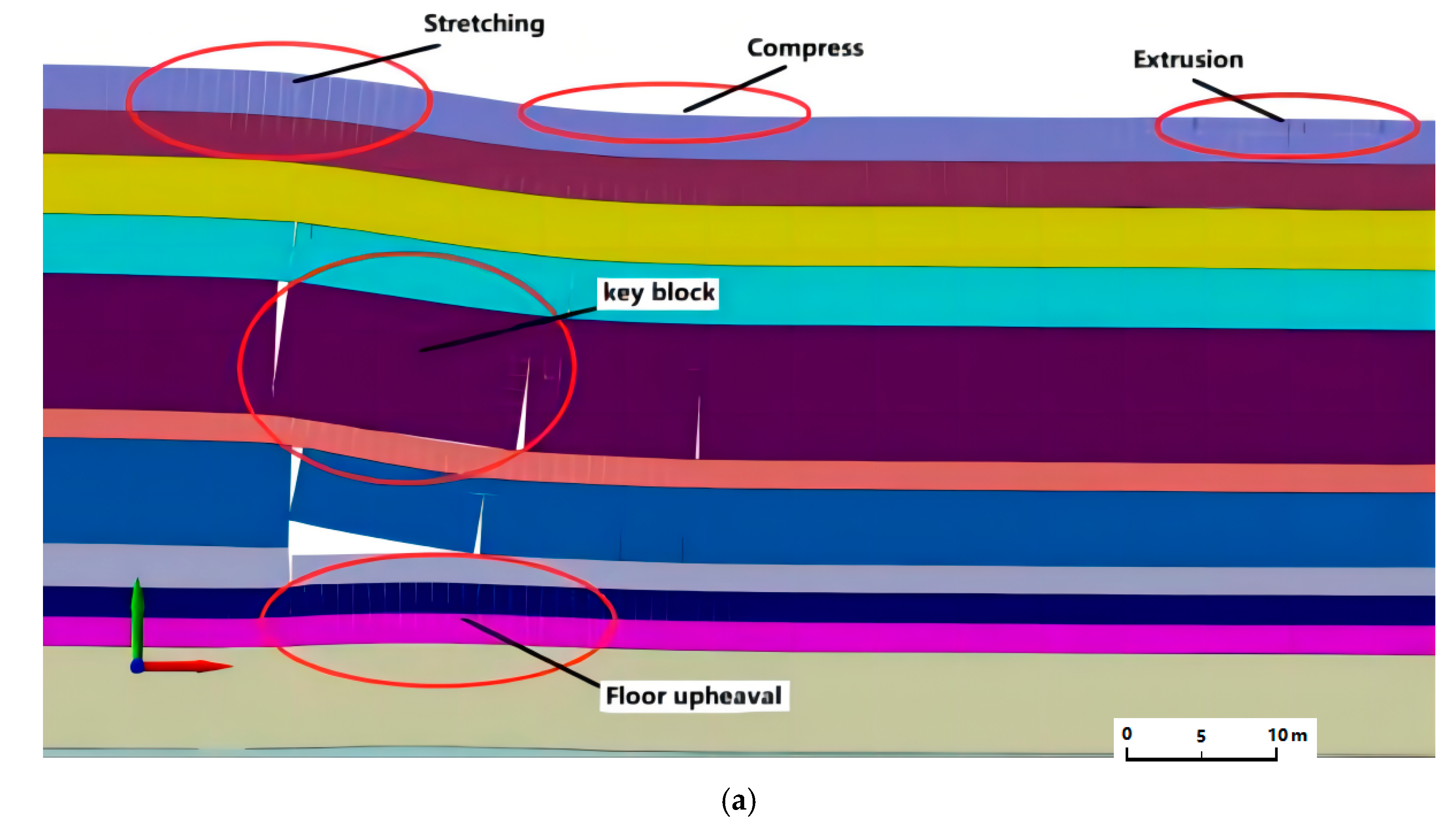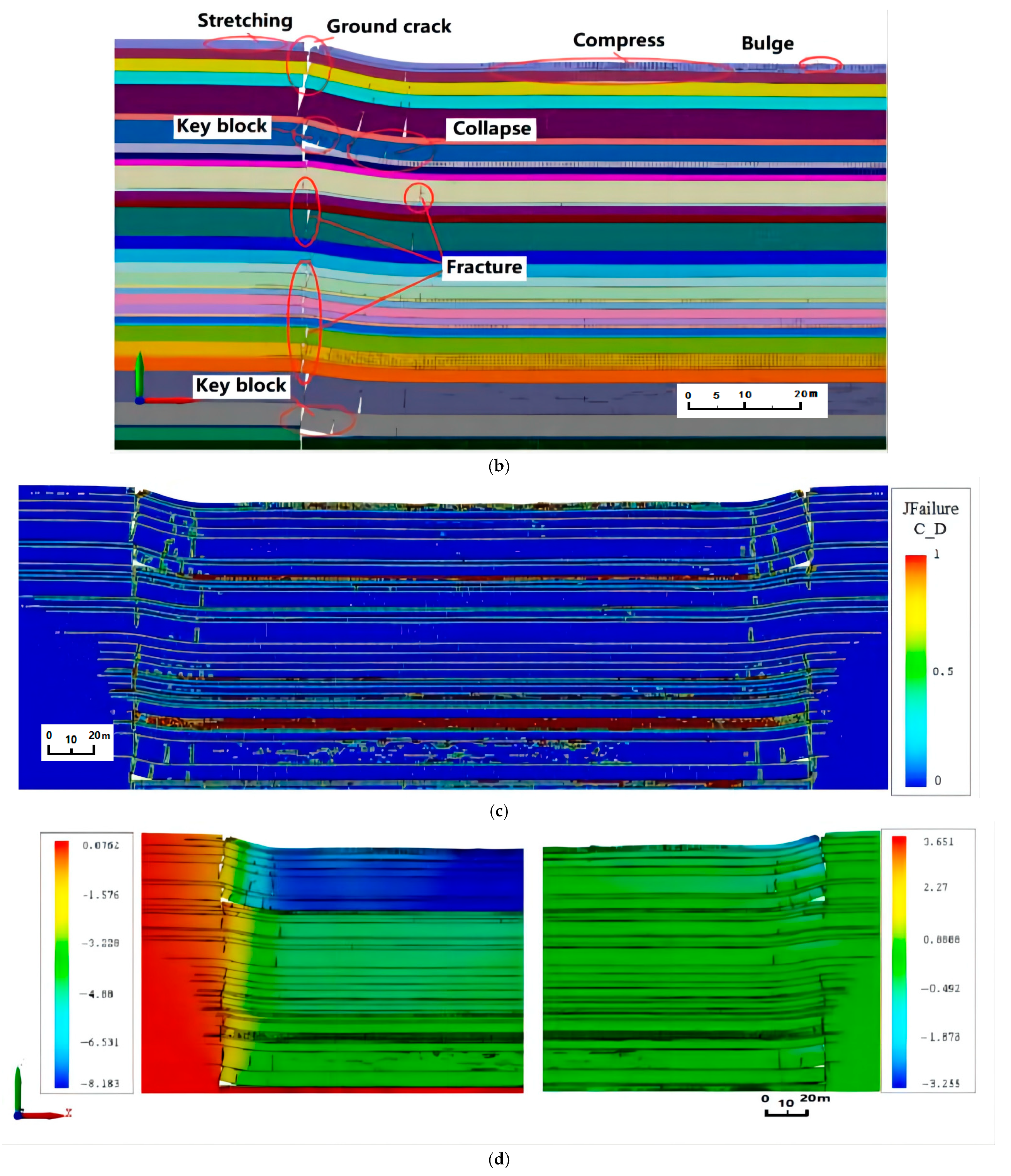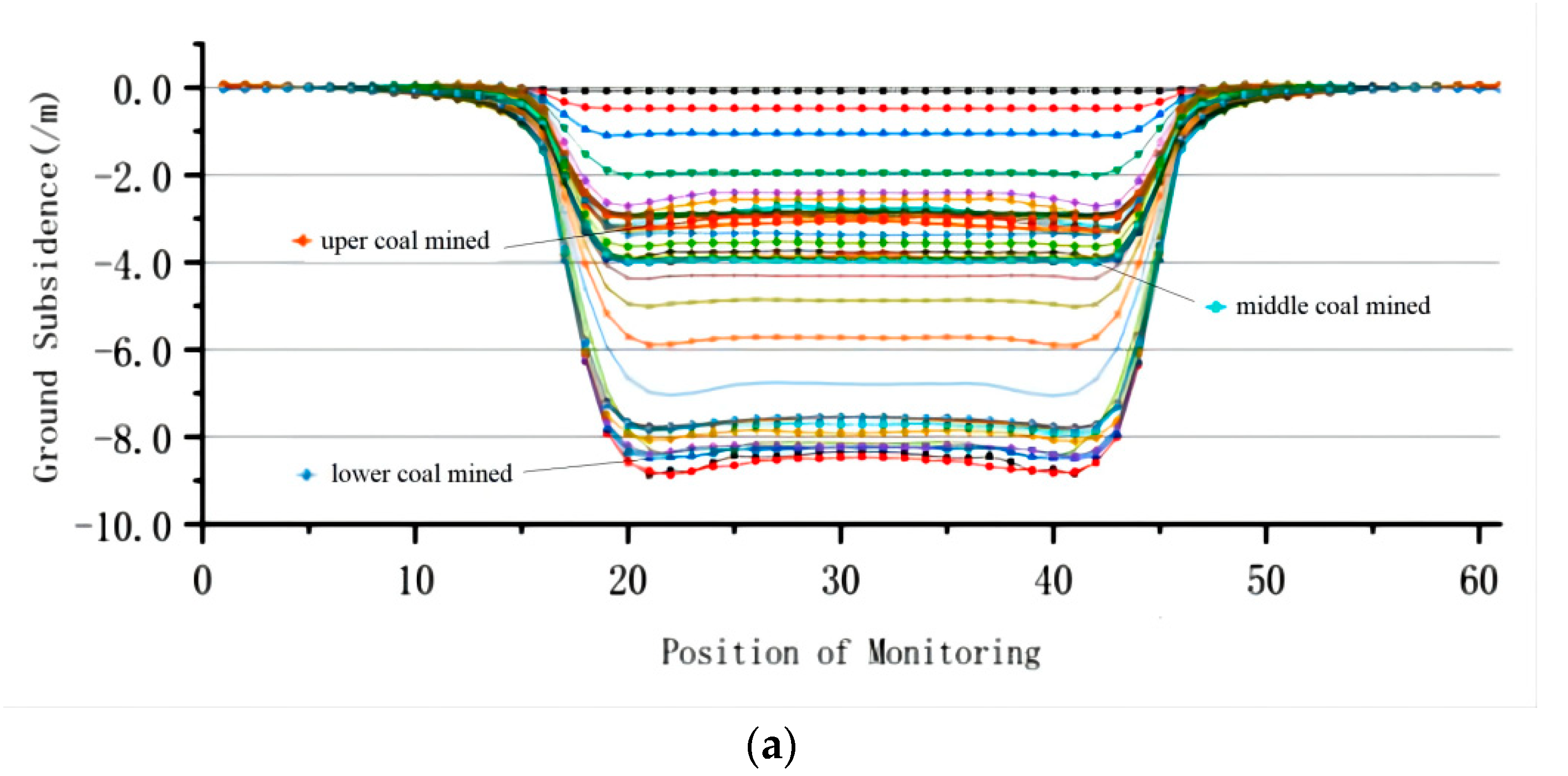Numerical Study on Characteristics of Bedrock and Surface Failure in Mining of Shallow-Buried MCS
Abstract
:1. Introduction
2. Methodology
2.1. The Calculation of Key Stratum Failure
2.2. CDEM Algorithm
3. Materials and Methods
3.1. Geological and Mining Conditions
3.2. Model and Mechanical Parameters
3.3. Simulation Scheme and Steps
4. Results
4.1. Analysis of Bedrock Failure Characteristics
4.2. Bedrock Failure Stress Analysis
4.3. Surface Deformation and Stress Characteristics
5. Discussion
5.1. The Bedrock Failure Process and Characteristics of MCS
5.2. Impact of Water on Mining Safety
5.3. Numerical Simulation Method
6. Conclusions
- (1)
- Affected by the repeated mining SBMCS, the bedrock is seriously damaged, and the bedrock is broken above the edge of the goaf, forming collapse pits, step cracks, and other failure forms. The weak rock stratum in the bedrock is affected by repeated mining to form a broken rock stratum belt. Repeated mining leads to a gradient change of bedrock subsidence. The settlement of mining 15# coal seam, and the settlement of bedrock between 15# coal and 9# coal is small, about 3.5–4.0 m, while the maximum settlement is 8.183 m on the ground.
- (2)
- After the bedrock breaks, it forms a broken block, which overlaps with the coal seam floor and surrounding rock to form a large suspended space. The size of the key blocks is directly related to the thickness and strength of the rock stratum, as well as the load on it. After discussion and analysis, the horizontal thrust between the collapsed blocks of the overlying rock is related to the tensile strength and thickness of the overlying rock. The cracks in the bedrock are relatively developed. The mining of the lower coal seam leads to a large number of pores and cracks in the upper bedrock and the collapsed rock mass in the goaf. The crack is connected with the surface, which makes it easy to form sand and water burst accidents.
- (3)
- The surface damage caused by SBMCS mining is more serious and complex. The amount of surface subsidence has the superposition effect of surface subsidence caused by repeated mining of MCS. The horizontal stress changes significantly along the edge of the surface subsidence basin, which is prone to tensile and compressive failure. The central part of the mobile basin is affected by repeated mining and presents complex vertical stress changes. The maximum stress reaches 100 KPa, and the minimum stress is about 77 KPa.
- (4)
- The CDEM algorithm has many advantages in the process of numerical simulation. The GDEM platform can organically combine a finite element and a discrete element, and it has a good effect on the numerical simulation of bedrock damage in coal mining. In this study, it is necessary to further study and analyze the coupling effect between water body and bedrock. The coupling mechanical model of water body and broken rock mass is established to study the influence of the coupling model on the stress and settlement of bedrock and surface.
Author Contributions
Funding
Institutional Review Board Statement
Informed Consent Statement
Data Availability Statement
Conflicts of Interest
References
- Li, B.; Wang, X.; Liu, Z.; Li, T. Study on multi-field catastrophe evolution laws of water inrush from concealed karst cave in roadway excavation: A case of Jiyuan coal mine. Geomat. Nat. Hazards Risk 2021, 12, 222–243. [Google Scholar] [CrossRef]
- Dong, L.; Tong, X.; Ma, J. Quantitative Investigation of Tomographic Effects in Abnormal Regions of Complex Structures. Engineering 2020, 7, 1011–1022. [Google Scholar] [CrossRef]
- Liu, G.; Zou, Y.; Zhang, W.; Chen, J. Characteristics of Overburden and Ground Failure in Mining of Shallow Buried Thick Coal Seams under Thick Aeolian Sand. Sustainability 2022, 14, 4028. [Google Scholar] [CrossRef]
- Xu, Z.; Liu, Q.; Zheng, Q.; Cheng, H.; Wu, Y. Isotopic composition and content of coalbed methane production gases and waters in karstic collapse column area, Qinshui Coalfield, China. J. Geochem. Explor. 2016, 165, 94–101. [Google Scholar] [CrossRef]
- Zhang, Z.X.; Zhang, Y.B.; Zhao, Z.H.; Zhang, L.M. Similar simulation experimental study on overburden movement and surface deformation law in multi coal seam mining. Hydro Eng. Geo 2011, 38, 130–134. [Google Scholar]
- Lin, Z.Y. Study on Coalfield Structure and Structural Coal Control in Coal Bearing Area of North China; China University of Mining and Technology: Beijing, China, 2021. [Google Scholar]
- Ma, L.; Jin, Z.; Liang, J.; Sun, H.; Zhang, D.; Li, P. Simulation of water resource loss in short–distance coal seams disturbed by repeated mining. Environ. Earth Sci. 2015, 74, 5653–5662. [Google Scholar] [CrossRef]
- Qin, Y. Research on Rock Movement Law in Multi Coal Seam Mining; China University of Geosciences: Beijing, China, 2021. [Google Scholar] [CrossRef]
- Dong, C. Research on Overlying Rock and Surface Movement and Deformation under Repeated Mining; Taiyuan University of Technology: Taiyuan, China, 2020. [Google Scholar] [CrossRef]
- Li, Z.C.; Li, L.C.; Wang, S.R.; Ma, S.; Zhang, Z.L.; Li, A.S.; Huang, B.; Zhang, L.Y.; Wang, Z.L.; Zhang, Q.S. Formation of X-shaped hydraulic fractures in deep thick glutenite reservoirs: A case study in Bohai Bay Basin, East China. J. Cent. South Univ. 2021, 28, 2814–2829. [Google Scholar] [CrossRef]
- Chen, J.J.; Nan, H.; Yan, W.T.; Guo, W.B.; Zou, Y.F. Dynamic surface movement and deformation characteristics of shallow buried deep high–intensity mining. Coal Sci. Technol. 2016, 44, 158–162. [Google Scholar]
- Yan, W.T.; Chen, J.J.; Chai, H.B.; Yan, S.G. Dynamic prediction model of surface damage in high–intensity mining area. J. Agric. Eng. 2019, 35, 267–273. [Google Scholar]
- Dong, L.; Chen, Y.; Sun, D.; Zhang, Y. Implications for rock instability precursors and principal stress direction from rock acoustic experiments. Int. J. Min. Sci. Technol. 2021, 31, 789–798. [Google Scholar] [CrossRef]
- Xie, S.R.; Pan, H.; Chen, D.D.; Gao, M.M.; He, S.S.; Song, B.H. Equivalent basic roof structure between layers and its activity law in multi coal seam mining. J. China Univ. Min. Technol. 2017, 46, 1218–1225. [Google Scholar]
- Zhao, X.L.; Wang, Y.Q.; Gao, G.Q.; Wu, Y. Safety analysis of coal mining pavement under expressway based on UDEC and settlement prediction. Coal Technol. 2020, 39, 123–127. [Google Scholar]
- Wu, Y.L.; Yu, Z.R.; Yan, Z.H.; Zhu, S.Y. Numerical simulation of development characteristics of “two zones” of repeated mining in the first mining face of shallow mining area. Coal Mine Saf. 2019, 50, 199–203. [Google Scholar]
- Feng, C.; Li, S.H.; Liu, X.H.; Zhang, Y.N. A semi–spring and semi–edge combined contact model in CDEM and its application to analysis of Jiweishan landslide. J. Rock Mech. Geotech. Eng. 2014, 6, 26–35. [Google Scholar] [CrossRef] [Green Version]
- Gao, H.; Feng, C.; Zhu, X.; Zhang, Y.; Wang, X.; Xin, X.; Shen, Y.; Sun, Z. Three dimensional analysis of coal seam gas fracturing mining based on continuous discontinuous element. J. Shandong Univ. 2021, 6, 119–128. Available online: https://kns.cnki.net/kcms/detail/37.1391.T.20210906.0941.010.html (accessed on 6 September 2021).
- Beijing Jidao Chengran Technology Co. Operation Manual of Block Dynamics Analysis Software GDEM Blockdyna (v1.0); Beijing Jidao Chengran Technology Co., Ltd.: Beijing, China, 2021. [Google Scholar]
- Qian, M.; Miao, X.; Xu, J. Theoretical study on key stratum in strata control. J. China Coal Soc. 1996, 21, 12–23. [Google Scholar]
- Xu, J.; Qian, M. Method for identifying the location of key overburden layers. J. China Univ. Min. Technol. 2000, 29, 463–467. [Google Scholar]
- Li, S.H.; Wang, J.G.; Liu, B.S.; Dong, D.P. Analysis of criticalexcavation depth for a jointed rock slope using a face-to-face discrete element method. Rock Mech. Rock Eng. 2007, 40, 331–348. [Google Scholar] [CrossRef]
- Ma, C.C.; Chen, K.Z.; Li, T.B.; Zeng, J.; Ma, J.J. Numerical simulation of stress structure rockburst based on GDEM. Tunn. Undergr. Eng. Disaster Prev. 2020, 2, 85–94. [Google Scholar]
- Hou, Z.J. Discussion on “short masonry beam”, “stepped rock beam” structure and masonry beam theory in shallow coal seam. J. Coal 2008, 11, 1201–1204. [Google Scholar]
- Zhang, J.P. Study on Development Law and Prediction Method of Overburden Fractures in Coal Seam Mining in Shendong Mining Area; Henan Polytechnic University: Henan, China, 2017. [Google Scholar]
- Zhao, Y.; Zhou, C.; Zhang, X.; Yuan, C. The pressure arching effect and distribution characteristics offractured strata of single key layer under shallow buried condition. J. China Coal Soc. 2020, 45, 1–11. [Google Scholar] [CrossRef]
- Sawamura, Y.; Ishihara, H.; Otani, Y.; Kishida, K.; Kimura, M. Deformation behavior and acting earth pressure of three-hinge precast arch culvert in construction process. Undergr. Space 2019, 4, 251–260. [Google Scholar] [CrossRef]
- Wang, D.; Guo, F.; Jia, L.; Xu, X. Three–dimensional stability analysis of soft rock slope along the slope of CDEM open–pit coal mine. J. Saf. Environ. 2021, 21, 195–200. [Google Scholar] [CrossRef]
- Wang, X.B. Study on the Coupling Continuous Discontinuous Method of Lagrangian Element and Discrete Element; Science Press: Beijing, China, 2021. [Google Scholar]
- Ju, J.; Xu, J.; Zhu, W. Longwall chock sudden closure incident below coal pillar of adjacent upper mined coal seam under shallow cover in the Shendong coalfield. Int. J. Rock Mech. Min. Sci. 2015, 77, 192–201. [Google Scholar] [CrossRef]
- Deguchi, T.; Kato, M.; Akcin, H.; Kutoglu, H.S. Monitoring of Mining Induced Land Subsidence Using L– and C–band SAR Interferometry. In Proceedings of the IEEE International Geoscience and Remote Sensing Symposium 2007, Barcelona, Spain, 23–28 July 2007; pp. 2122–2125. [Google Scholar] [CrossRef]
- Li, G.; Peng, S.; He, B.; Peng, X.; Yuan, C.; Hu, C. Detection of Coalbed Fractures with P–wave Azimuthal AVO in 3–D Seismic Exploration. Chin. Sci. Bull. 2005, 50, 146–150. [Google Scholar] [CrossRef]
- Cross, T.A. Stratigraphic controls on reservoir attributes in continental strata. Earth Sci. Front. 2000, 7, 322–350. [Google Scholar]
- Ahmad, A.; Kourosh, S. Prediction of surface subsidence due to inclined coal seam mining using profile function (Prediction of surface subsidence due to inclined coal seam mining using profile function). J. Sci. Technol. 2005, 16, 9–18. [Google Scholar]
- He, M.; Zhu, G.; Guo, Z. Longwall mining “cutting cantilever beam theory” and 110 mining method in China—The third mining science innovation. Chin. J. Rock Mech. Geotech. Eng. Engl. Ed. 2015, 5, 10. [Google Scholar] [CrossRef] [Green Version]
- Wang, A.; Wang, J. Study on Underground Pressure Law of Large Mining Height Fully Mechanized Face in Soft Rock Shallow Coal Seam. Sci. Technol. Datong Coal Min. Adm. 2016, 4, 20–24. [Google Scholar]
- Zou, Y. Evolution Mechanism and Regulation of Surface Ecological Environment under High Intensity Mining; Science Press: Beijing, China, 2019. [Google Scholar]
- Guo, H.; Ji, M.; Chen, K.; Zhang, Z.; Zhang, Y.; Zhang, M. The Feasibility of Mining Under a Water Body Based on a Fuzzy Neural Network. Mine Water Environ. 2018, 37, 703–712. [Google Scholar] [CrossRef]
- Li, Y.; Zhou, H.; Zhu, W.; Li, S.; Liu, J. Numerical Study on Crack Propagation in Brittle Jointed Rock Mass Influenced by Fracture Water Pressure. Materials 2015, 8, 3364–3376. [Google Scholar] [CrossRef] [Green Version]










| LITHOLOGY | ρ (/Kg/m3) | E (/GPa) | μ | c (/MPa) | σt (/MPa) | φ (/°) |
|---|---|---|---|---|---|---|
| Loess and Sand Gravel | 1900 | 0.015 | 0.30 | 0.02 | 0.60 | 17.0 |
| Mudstone | 2200 | 1.31 | 0.24 | 2.16 | 3.73 | 25.0 |
| Sandstone and Mudstone | 2440 | 2.23 | 0.25 | 3.80 | 4.25 | 30.0 |
| Sandstone | 2640 | 3.54 | 0.25 | 5.50 | 4.78 | 35.0 |
| Limestone | 2800 | 2.66 | 0.23 | 6.20 | 7.98 | 35.0 |
| Sandy Mudstone | 2613 | 0.90 | 0.26 | 5.50 | 4.78 | 30.0 |
| Siltstone | 2540 | 3.16 | 0.35 | 2.65 | 1.36 | 31.0 |
| Coal | 1400 | 1.00 | 0.29 | 1.25 | 1.60 | 25.0 |
Publisher’s Note: MDPI stays neutral with regard to jurisdictional claims in published maps and institutional affiliations. |
© 2022 by the authors. Licensee MDPI, Basel, Switzerland. This article is an open access article distributed under the terms and conditions of the Creative Commons Attribution (CC BY) license (https://creativecommons.org/licenses/by/4.0/).
Share and Cite
Liu, G.; Zhang, W.; Zou, Y.; Chai, H.; Xue, Y. Numerical Study on Characteristics of Bedrock and Surface Failure in Mining of Shallow-Buried MCS. Energies 2022, 15, 3446. https://doi.org/10.3390/en15093446
Liu G, Zhang W, Zou Y, Chai H, Xue Y. Numerical Study on Characteristics of Bedrock and Surface Failure in Mining of Shallow-Buried MCS. Energies. 2022; 15(9):3446. https://doi.org/10.3390/en15093446
Chicago/Turabian StyleLiu, Guangchun, Wenzhi Zhang, Youfeng Zou, Huabin Chai, and Yongan Xue. 2022. "Numerical Study on Characteristics of Bedrock and Surface Failure in Mining of Shallow-Buried MCS" Energies 15, no. 9: 3446. https://doi.org/10.3390/en15093446
APA StyleLiu, G., Zhang, W., Zou, Y., Chai, H., & Xue, Y. (2022). Numerical Study on Characteristics of Bedrock and Surface Failure in Mining of Shallow-Buried MCS. Energies, 15(9), 3446. https://doi.org/10.3390/en15093446







